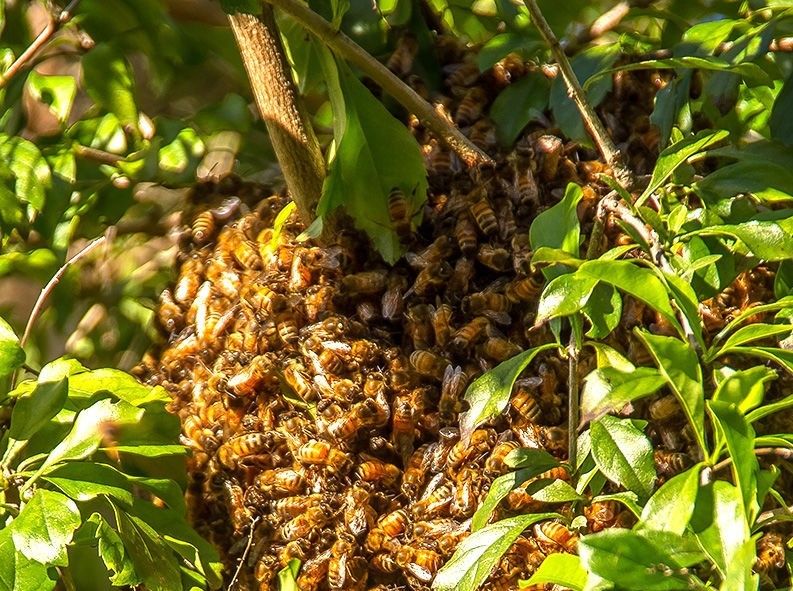Monitor, manage and minimise swarms
Keeping your bees happy, healthy and swarm-free.
Swarming may be natural bee behaviour, but it’s not popular with most beekeepers. When a colony swarms, roughly half the population, including the queen, leaves the hive in search of a new home. Beekeepers are left with a depleted hive that needs to rebuild its population before winter.
You can’t always prevent swarms, but if you’re diligent about monitoring your hives, you may be able to head them off before they start. Spring and summer are prime swarming times, so it’s important to know what you’re looking for – before it’s too late.
Here’s your guide to swarm-spotting and prevention:
Why do bees swarm?
Swarms are usually a sign that your colony is healthy and thriving. Like all living organisms, bees have an internal drive to spread their genetic material and increase their number of offspring. If the colony is healthy and well-supplied with food during spring and summer, the population will expand and outgrow the space in its hive, this is one of the more common causes of swarming behaviour.
During spring and summer, the population in the hive increases from around 20,000 bees to roughly 60,000. That’s a huge number of extra bees to fit into a small space. If you don’t expand the hive, bees will start to feel overcrowded and uncomfortable – which could trigger a swarm.
Swarming can be problematic for a few reasons. For beekeepers, it means the loss of productive bees. For the bees that leave the hive, it’s not always positive – only one in six swarms survive the journey from the hive, with most failing before they manage to establish a new home base.
Signs of swarming
Swarming doesn’t happen overnight. As the population in the hive increases, bees will start to prepare for a swarm. Because the original queen leaves with the swarm, the remaining bees will need to raise a new queen in her place. This involves creating special queen cells and feeding the larvae a diet rich in royal jelly so they develop the characteristic anatomy of queen bees.
Identifying queen cells is one of the easiest ways to spot a swarm before it starts. Queen cells, also known as queen cups, are larger than normal brood cells. Shaped like peanut shells, they appear around the edges of brood frames. If they’re empty, it means your bees could be preparing for a swarm. If they’re capped – a swarm is imminent.
Other signs to watch are brood numbers, population numbers and honey stores. If these are outgrowing the available space, you need to make a change in the hive before it’s too late.
One final sign – activity. If movement in and out of the hive suddenly drops off, it could mean that a swarm has already happened, and the population in your hive has been reduced.
Swarm prevention
Prevention should start well before you see any signs of an upcoming swarm. The best way is to give your bees plenty of space for brood, honey storage and movement.
Here’s how:
Add more space
After minimising your hive space in winter, you need to add hardware in spring and summer. As brood frames and honey stores build up, the bees will need more space to fill. Watch the existing frames closely and expand when they hit around 70% capacity or seven out of ten frames in a box.
Restructure the hive
Reversing the hive can give your bees more room without the need for extra gear. During winter, the colony tends to move to the top of the hive in search of warmth. This means brood is clustered in the top box of the hive. Usually, the queen and the colony will stay in that spot even as spring approaches, leaving the lower part of the hive empty.
Reverse the hive by moving the full hive box to the bottom of the stack, and moving the empty boxes to the top. Then, as the bees naturally move upwards they fill the available space.
Add a top entrance
Sometimes, overcrowding can disrupt order in the hive, which can prompt a swarm. Pollen or honey stored in brood frames, or brood being laid in honey frames, can indicate that your bees don’t have enough space. Increase the number of brood and honey frames, and add a top entrance so worker bees don’t need to move through brood to get to the honey frames.
Ventilation matters
When a hive gets full, it can feel hot and stuffy. Ventilating can help bees feel less crowded, even if the space stays the same. Add a slatted bottom board or drill holes towards the top of the hive to make sure fresh air circulates through.
Swarm or split?
Sometimes, all the inspections and preventative measures in the world can’t stop a swarm. If you think your hive is on the verge of swarming, you can choose to split the hive into two colonies – or take bees from two healthy hives and create a third. Then, rather than losing half your colony you gain a brand new one – which means more honey at the end of the season.
Splitting is fairly simple, but it should be done early in the season so both colonies have time to rebuild their honey stores and population before winter. As with most things beekeeping there are plenty of different techniques to split your hive. See our step-by-step guide to hivesplitting here.
Watch out for swarm warnings
Swarming isn’t inherently negative – in fact, it’s a sign that your colony is healthy and thriving. But for beekeepers, it means a loss of bees and a weaker colony. If you keep a close eye on your bees, maintain your hives to prevent overcrowding, and prepare to split hives if needed, you can stop many swarms before they happen.
Ready to start your first hive? Get set up with Ecrotek’s range of high-quality beekeeping gear.

